Green Building Concept in Qatar: A Comprehensive Research Report
VerifiedAdded on 2020/01/07
|10
|2895
|267
Report
AI Summary
This report investigates the green building concept, focusing on its application and impact within Qatar. It begins with an abstract and a literature review, establishing the importance of sustainable building practices for energy and water conservation, as well as pollution reduction. The research aims to assess the effectiveness of green building in environmental protection, employing both primary data collection through questionnaires and secondary data from existing literature. The methodology includes an exploratory research design, an inductive research approach, and an interpretative research philosophy. Data analysis will be conducted using SPSS to test the hypothesis of a positive impact on the environment, with considerations for validity, reliability, and limitations such as a small sample size. The report outlines a detailed research plan, including a timeline for key activities such as problem identification, literature review, data collection, and analysis, to provide a comprehensive understanding of green building's role in Qatar's sustainable development. The report also highlights the potential economic and social benefits of green buildings, while acknowledging the potential negative impacts such as the cost of construction and health concerns related to indoor air quality, aiming to provide a balanced perspective on the concept.
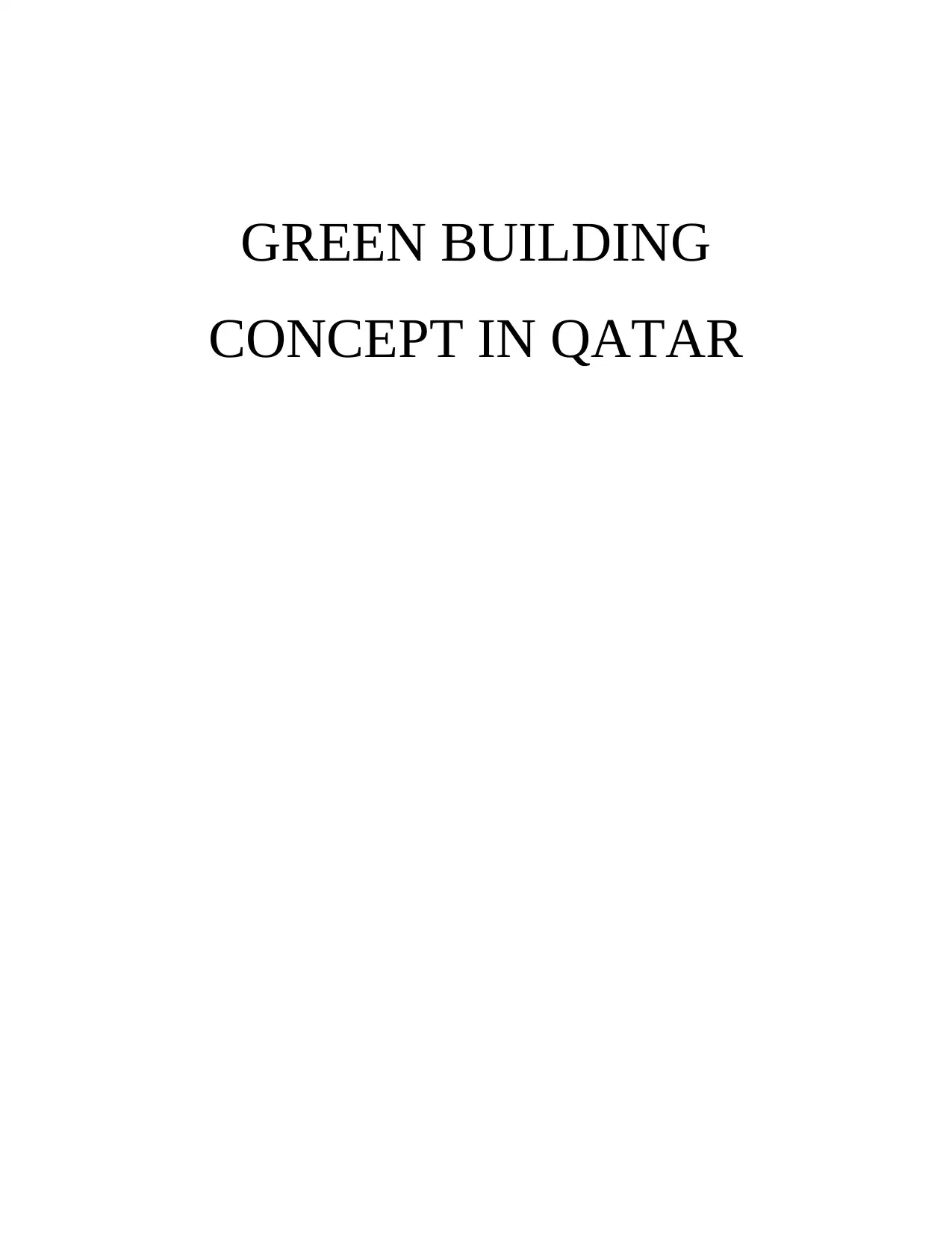
GREEN BUILDING
CONCEPT IN QATAR
CONCEPT IN QATAR
Paraphrase This Document
Need a fresh take? Get an instant paraphrase of this document with our AI Paraphraser
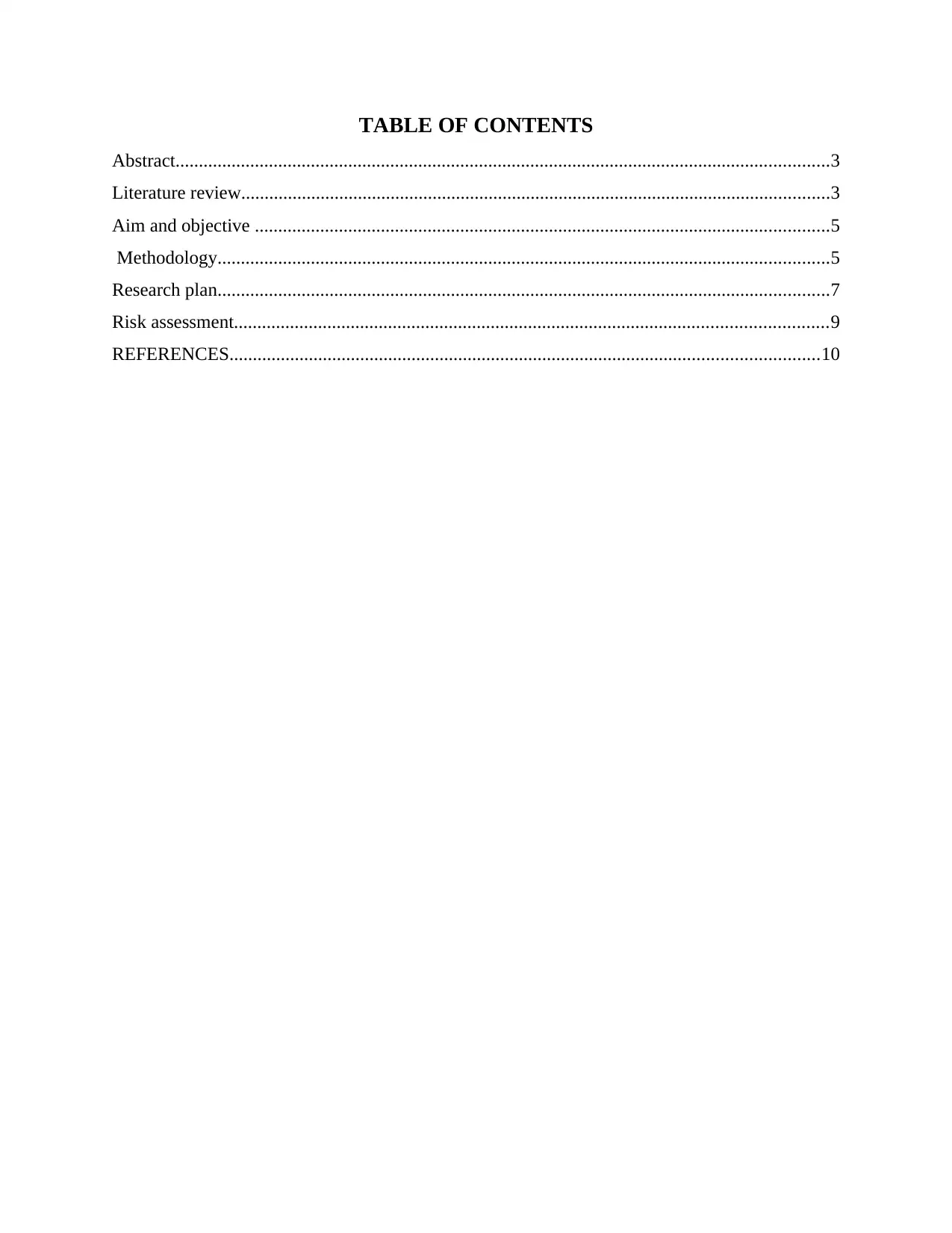
TABLE OF CONTENTS
Abstract............................................................................................................................................3
Literature review..............................................................................................................................3
Aim and objective ...........................................................................................................................5
Methodology...................................................................................................................................5
Research plan...................................................................................................................................7
Risk assessment...............................................................................................................................9
REFERENCES..............................................................................................................................10
Abstract............................................................................................................................................3
Literature review..............................................................................................................................3
Aim and objective ...........................................................................................................................5
Methodology...................................................................................................................................5
Research plan...................................................................................................................................7
Risk assessment...............................................................................................................................9
REFERENCES..............................................................................................................................10
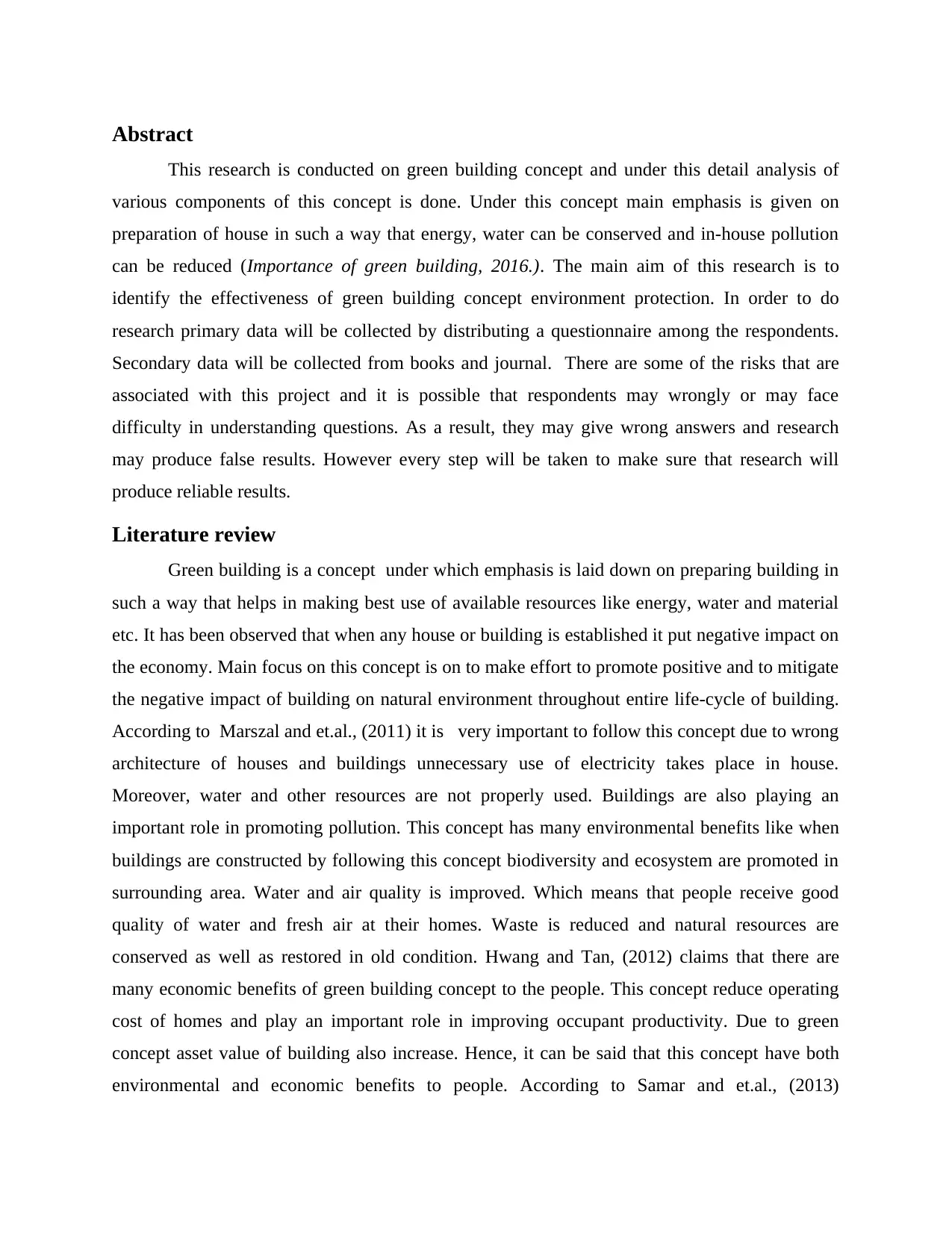
Abstract
This research is conducted on green building concept and under this detail analysis of
various components of this concept is done. Under this concept main emphasis is given on
preparation of house in such a way that energy, water can be conserved and in-house pollution
can be reduced (Importance of green building, 2016.). The main aim of this research is to
identify the effectiveness of green building concept environment protection. In order to do
research primary data will be collected by distributing a questionnaire among the respondents.
Secondary data will be collected from books and journal. There are some of the risks that are
associated with this project and it is possible that respondents may wrongly or may face
difficulty in understanding questions. As a result, they may give wrong answers and research
may produce false results. However every step will be taken to make sure that research will
produce reliable results.
Literature review
Green building is a concept under which emphasis is laid down on preparing building in
such a way that helps in making best use of available resources like energy, water and material
etc. It has been observed that when any house or building is established it put negative impact on
the economy. Main focus on this concept is on to make effort to promote positive and to mitigate
the negative impact of building on natural environment throughout entire life-cycle of building.
According to Marszal and et.al., (2011) it is very important to follow this concept due to wrong
architecture of houses and buildings unnecessary use of electricity takes place in house.
Moreover, water and other resources are not properly used. Buildings are also playing an
important role in promoting pollution. This concept has many environmental benefits like when
buildings are constructed by following this concept biodiversity and ecosystem are promoted in
surrounding area. Water and air quality is improved. Which means that people receive good
quality of water and fresh air at their homes. Waste is reduced and natural resources are
conserved as well as restored in old condition. Hwang and Tan, (2012) claims that there are
many economic benefits of green building concept to the people. This concept reduce operating
cost of homes and play an important role in improving occupant productivity. Due to green
concept asset value of building also increase. Hence, it can be said that this concept have both
environmental and economic benefits to people. According to Samar and et.al., (2013)
This research is conducted on green building concept and under this detail analysis of
various components of this concept is done. Under this concept main emphasis is given on
preparation of house in such a way that energy, water can be conserved and in-house pollution
can be reduced (Importance of green building, 2016.). The main aim of this research is to
identify the effectiveness of green building concept environment protection. In order to do
research primary data will be collected by distributing a questionnaire among the respondents.
Secondary data will be collected from books and journal. There are some of the risks that are
associated with this project and it is possible that respondents may wrongly or may face
difficulty in understanding questions. As a result, they may give wrong answers and research
may produce false results. However every step will be taken to make sure that research will
produce reliable results.
Literature review
Green building is a concept under which emphasis is laid down on preparing building in
such a way that helps in making best use of available resources like energy, water and material
etc. It has been observed that when any house or building is established it put negative impact on
the economy. Main focus on this concept is on to make effort to promote positive and to mitigate
the negative impact of building on natural environment throughout entire life-cycle of building.
According to Marszal and et.al., (2011) it is very important to follow this concept due to wrong
architecture of houses and buildings unnecessary use of electricity takes place in house.
Moreover, water and other resources are not properly used. Buildings are also playing an
important role in promoting pollution. This concept has many environmental benefits like when
buildings are constructed by following this concept biodiversity and ecosystem are promoted in
surrounding area. Water and air quality is improved. Which means that people receive good
quality of water and fresh air at their homes. Waste is reduced and natural resources are
conserved as well as restored in old condition. Hwang and Tan, (2012) claims that there are
many economic benefits of green building concept to the people. This concept reduce operating
cost of homes and play an important role in improving occupant productivity. Due to green
concept asset value of building also increase. Hence, it can be said that this concept have both
environmental and economic benefits to people. According to Samar and et.al., (2013)
⊘ This is a preview!⊘
Do you want full access?
Subscribe today to unlock all pages.

Trusted by 1+ million students worldwide
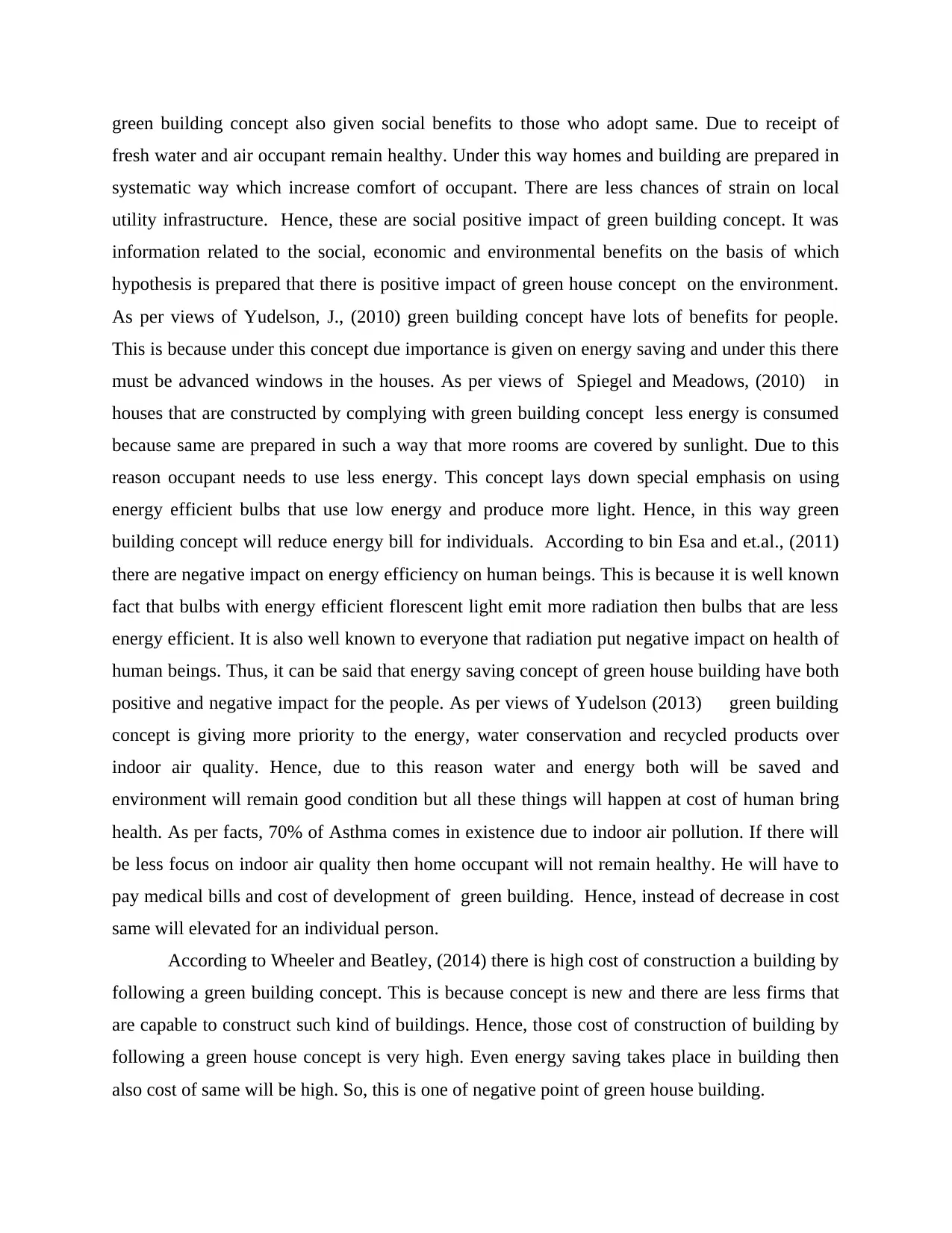
green building concept also given social benefits to those who adopt same. Due to receipt of
fresh water and air occupant remain healthy. Under this way homes and building are prepared in
systematic way which increase comfort of occupant. There are less chances of strain on local
utility infrastructure. Hence, these are social positive impact of green building concept. It was
information related to the social, economic and environmental benefits on the basis of which
hypothesis is prepared that there is positive impact of green house concept on the environment.
As per views of Yudelson, J., (2010) green building concept have lots of benefits for people.
This is because under this concept due importance is given on energy saving and under this there
must be advanced windows in the houses. As per views of Spiegel and Meadows, (2010) in
houses that are constructed by complying with green building concept less energy is consumed
because same are prepared in such a way that more rooms are covered by sunlight. Due to this
reason occupant needs to use less energy. This concept lays down special emphasis on using
energy efficient bulbs that use low energy and produce more light. Hence, in this way green
building concept will reduce energy bill for individuals. According to bin Esa and et.al., (2011)
there are negative impact on energy efficiency on human beings. This is because it is well known
fact that bulbs with energy efficient florescent light emit more radiation then bulbs that are less
energy efficient. It is also well known to everyone that radiation put negative impact on health of
human beings. Thus, it can be said that energy saving concept of green house building have both
positive and negative impact for the people. As per views of Yudelson (2013) green building
concept is giving more priority to the energy, water conservation and recycled products over
indoor air quality. Hence, due to this reason water and energy both will be saved and
environment will remain good condition but all these things will happen at cost of human bring
health. As per facts, 70% of Asthma comes in existence due to indoor air pollution. If there will
be less focus on indoor air quality then home occupant will not remain healthy. He will have to
pay medical bills and cost of development of green building. Hence, instead of decrease in cost
same will elevated for an individual person.
According to Wheeler and Beatley, (2014) there is high cost of construction a building by
following a green building concept. This is because concept is new and there are less firms that
are capable to construct such kind of buildings. Hence, those cost of construction of building by
following a green house concept is very high. Even energy saving takes place in building then
also cost of same will be high. So, this is one of negative point of green house building.
fresh water and air occupant remain healthy. Under this way homes and building are prepared in
systematic way which increase comfort of occupant. There are less chances of strain on local
utility infrastructure. Hence, these are social positive impact of green building concept. It was
information related to the social, economic and environmental benefits on the basis of which
hypothesis is prepared that there is positive impact of green house concept on the environment.
As per views of Yudelson, J., (2010) green building concept have lots of benefits for people.
This is because under this concept due importance is given on energy saving and under this there
must be advanced windows in the houses. As per views of Spiegel and Meadows, (2010) in
houses that are constructed by complying with green building concept less energy is consumed
because same are prepared in such a way that more rooms are covered by sunlight. Due to this
reason occupant needs to use less energy. This concept lays down special emphasis on using
energy efficient bulbs that use low energy and produce more light. Hence, in this way green
building concept will reduce energy bill for individuals. According to bin Esa and et.al., (2011)
there are negative impact on energy efficiency on human beings. This is because it is well known
fact that bulbs with energy efficient florescent light emit more radiation then bulbs that are less
energy efficient. It is also well known to everyone that radiation put negative impact on health of
human beings. Thus, it can be said that energy saving concept of green house building have both
positive and negative impact for the people. As per views of Yudelson (2013) green building
concept is giving more priority to the energy, water conservation and recycled products over
indoor air quality. Hence, due to this reason water and energy both will be saved and
environment will remain good condition but all these things will happen at cost of human bring
health. As per facts, 70% of Asthma comes in existence due to indoor air pollution. If there will
be less focus on indoor air quality then home occupant will not remain healthy. He will have to
pay medical bills and cost of development of green building. Hence, instead of decrease in cost
same will elevated for an individual person.
According to Wheeler and Beatley, (2014) there is high cost of construction a building by
following a green building concept. This is because concept is new and there are less firms that
are capable to construct such kind of buildings. Hence, those cost of construction of building by
following a green house concept is very high. Even energy saving takes place in building then
also cost of same will be high. So, this is one of negative point of green house building.
Paraphrase This Document
Need a fresh take? Get an instant paraphrase of this document with our AI Paraphraser
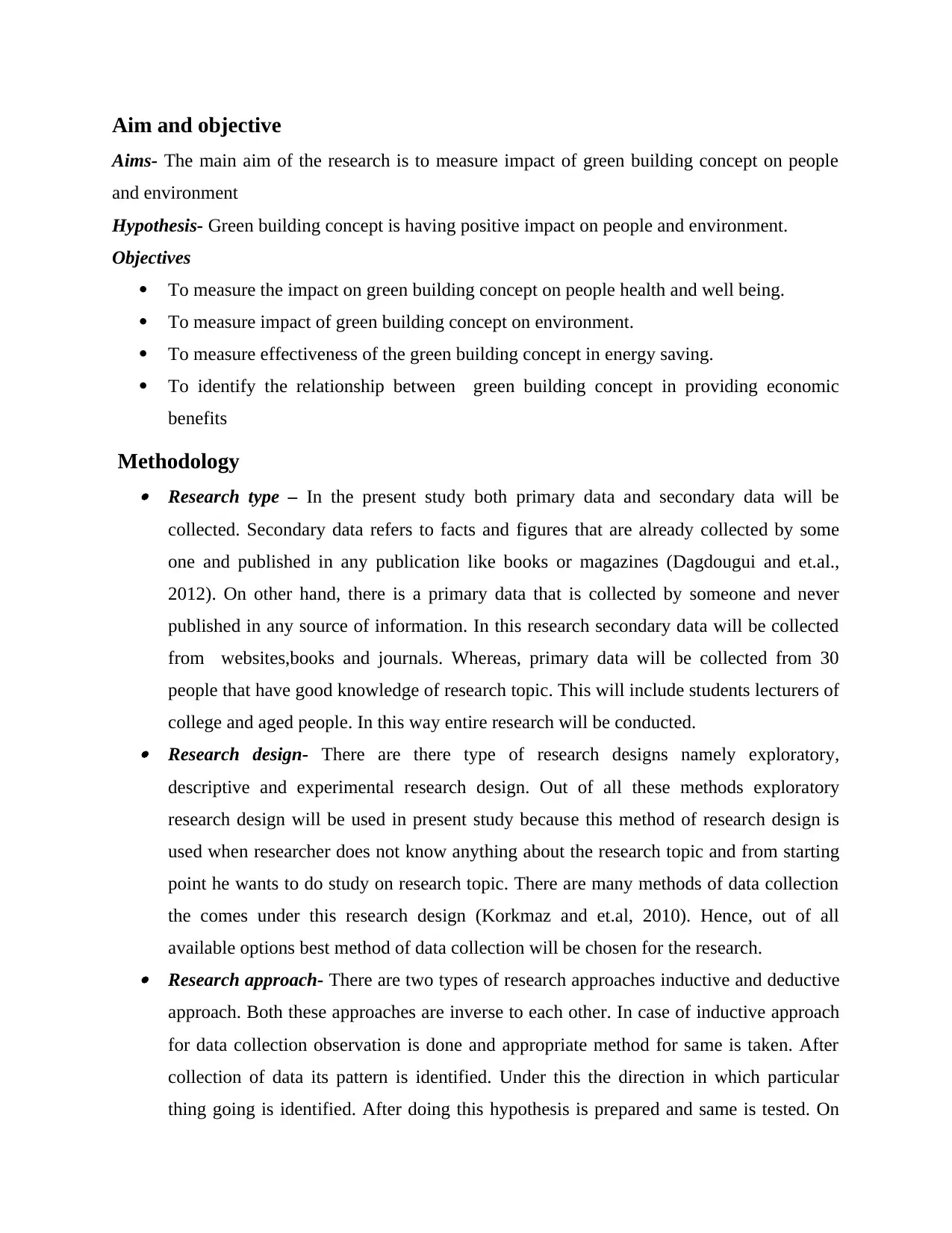
Aim and objective
Aims- The main aim of the research is to measure impact of green building concept on people
and environment
Hypothesis- Green building concept is having positive impact on people and environment.
Objectives
To measure the impact on green building concept on people health and well being.
To measure impact of green building concept on environment.
To measure effectiveness of the green building concept in energy saving.
To identify the relationship between green building concept in providing economic
benefits
Methodology Research type – In the present study both primary data and secondary data will be
collected. Secondary data refers to facts and figures that are already collected by some
one and published in any publication like books or magazines (Dagdougui and et.al.,
2012). On other hand, there is a primary data that is collected by someone and never
published in any source of information. In this research secondary data will be collected
from websites,books and journals. Whereas, primary data will be collected from 30
people that have good knowledge of research topic. This will include students lecturers of
college and aged people. In this way entire research will be conducted. Research design- There are there type of research designs namely exploratory,
descriptive and experimental research design. Out of all these methods exploratory
research design will be used in present study because this method of research design is
used when researcher does not know anything about the research topic and from starting
point he wants to do study on research topic. There are many methods of data collection
the comes under this research design (Korkmaz and et.al, 2010). Hence, out of all
available options best method of data collection will be chosen for the research. Research approach- There are two types of research approaches inductive and deductive
approach. Both these approaches are inverse to each other. In case of inductive approach
for data collection observation is done and appropriate method for same is taken. After
collection of data its pattern is identified. Under this the direction in which particular
thing going is identified. After doing this hypothesis is prepared and same is tested. On
Aims- The main aim of the research is to measure impact of green building concept on people
and environment
Hypothesis- Green building concept is having positive impact on people and environment.
Objectives
To measure the impact on green building concept on people health and well being.
To measure impact of green building concept on environment.
To measure effectiveness of the green building concept in energy saving.
To identify the relationship between green building concept in providing economic
benefits
Methodology Research type – In the present study both primary data and secondary data will be
collected. Secondary data refers to facts and figures that are already collected by some
one and published in any publication like books or magazines (Dagdougui and et.al.,
2012). On other hand, there is a primary data that is collected by someone and never
published in any source of information. In this research secondary data will be collected
from websites,books and journals. Whereas, primary data will be collected from 30
people that have good knowledge of research topic. This will include students lecturers of
college and aged people. In this way entire research will be conducted. Research design- There are there type of research designs namely exploratory,
descriptive and experimental research design. Out of all these methods exploratory
research design will be used in present study because this method of research design is
used when researcher does not know anything about the research topic and from starting
point he wants to do study on research topic. There are many methods of data collection
the comes under this research design (Korkmaz and et.al, 2010). Hence, out of all
available options best method of data collection will be chosen for the research. Research approach- There are two types of research approaches inductive and deductive
approach. Both these approaches are inverse to each other. In case of inductive approach
for data collection observation is done and appropriate method for same is taken. After
collection of data its pattern is identified. Under this the direction in which particular
thing going is identified. After doing this hypothesis is prepared and same is tested. On
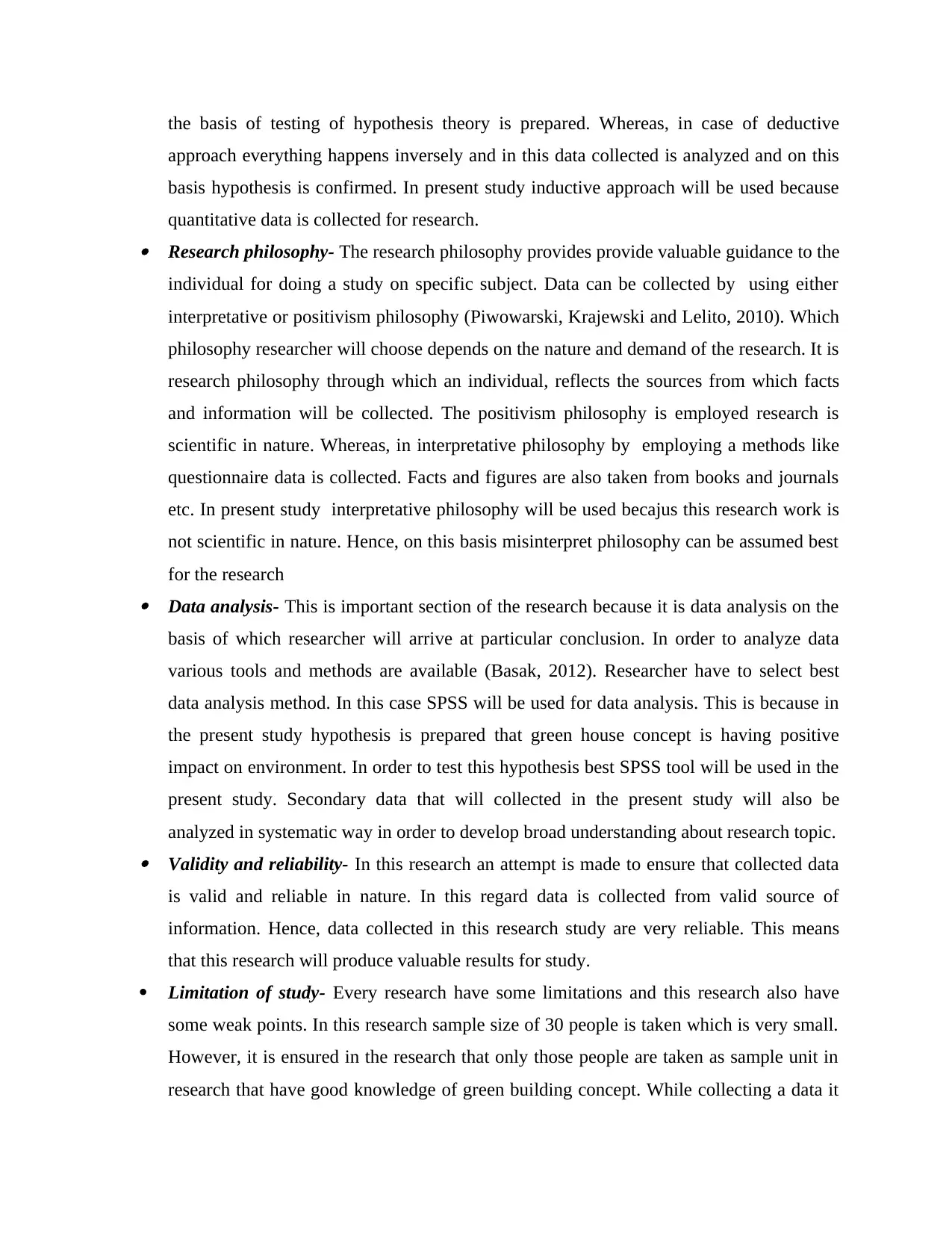
the basis of testing of hypothesis theory is prepared. Whereas, in case of deductive
approach everything happens inversely and in this data collected is analyzed and on this
basis hypothesis is confirmed. In present study inductive approach will be used because
quantitative data is collected for research. Research philosophy- The research philosophy provides provide valuable guidance to the
individual for doing a study on specific subject. Data can be collected by using either
interpretative or positivism philosophy (Piwowarski, Krajewski and Lelito, 2010). Which
philosophy researcher will choose depends on the nature and demand of the research. It is
research philosophy through which an individual, reflects the sources from which facts
and information will be collected. The positivism philosophy is employed research is
scientific in nature. Whereas, in interpretative philosophy by employing a methods like
questionnaire data is collected. Facts and figures are also taken from books and journals
etc. In present study interpretative philosophy will be used becajus this research work is
not scientific in nature. Hence, on this basis misinterpret philosophy can be assumed best
for the research Data analysis- This is important section of the research because it is data analysis on the
basis of which researcher will arrive at particular conclusion. In order to analyze data
various tools and methods are available (Basak, 2012). Researcher have to select best
data analysis method. In this case SPSS will be used for data analysis. This is because in
the present study hypothesis is prepared that green house concept is having positive
impact on environment. In order to test this hypothesis best SPSS tool will be used in the
present study. Secondary data that will collected in the present study will also be
analyzed in systematic way in order to develop broad understanding about research topic. Validity and reliability- In this research an attempt is made to ensure that collected data
is valid and reliable in nature. In this regard data is collected from valid source of
information. Hence, data collected in this research study are very reliable. This means
that this research will produce valuable results for study.
Limitation of study- Every research have some limitations and this research also have
some weak points. In this research sample size of 30 people is taken which is very small.
However, it is ensured in the research that only those people are taken as sample unit in
research that have good knowledge of green building concept. While collecting a data it
approach everything happens inversely and in this data collected is analyzed and on this
basis hypothesis is confirmed. In present study inductive approach will be used because
quantitative data is collected for research. Research philosophy- The research philosophy provides provide valuable guidance to the
individual for doing a study on specific subject. Data can be collected by using either
interpretative or positivism philosophy (Piwowarski, Krajewski and Lelito, 2010). Which
philosophy researcher will choose depends on the nature and demand of the research. It is
research philosophy through which an individual, reflects the sources from which facts
and information will be collected. The positivism philosophy is employed research is
scientific in nature. Whereas, in interpretative philosophy by employing a methods like
questionnaire data is collected. Facts and figures are also taken from books and journals
etc. In present study interpretative philosophy will be used becajus this research work is
not scientific in nature. Hence, on this basis misinterpret philosophy can be assumed best
for the research Data analysis- This is important section of the research because it is data analysis on the
basis of which researcher will arrive at particular conclusion. In order to analyze data
various tools and methods are available (Basak, 2012). Researcher have to select best
data analysis method. In this case SPSS will be used for data analysis. This is because in
the present study hypothesis is prepared that green house concept is having positive
impact on environment. In order to test this hypothesis best SPSS tool will be used in the
present study. Secondary data that will collected in the present study will also be
analyzed in systematic way in order to develop broad understanding about research topic. Validity and reliability- In this research an attempt is made to ensure that collected data
is valid and reliable in nature. In this regard data is collected from valid source of
information. Hence, data collected in this research study are very reliable. This means
that this research will produce valuable results for study.
Limitation of study- Every research have some limitations and this research also have
some weak points. In this research sample size of 30 people is taken which is very small.
However, it is ensured in the research that only those people are taken as sample unit in
research that have good knowledge of green building concept. While collecting a data it
⊘ This is a preview!⊘
Do you want full access?
Subscribe today to unlock all pages.

Trusted by 1+ million students worldwide
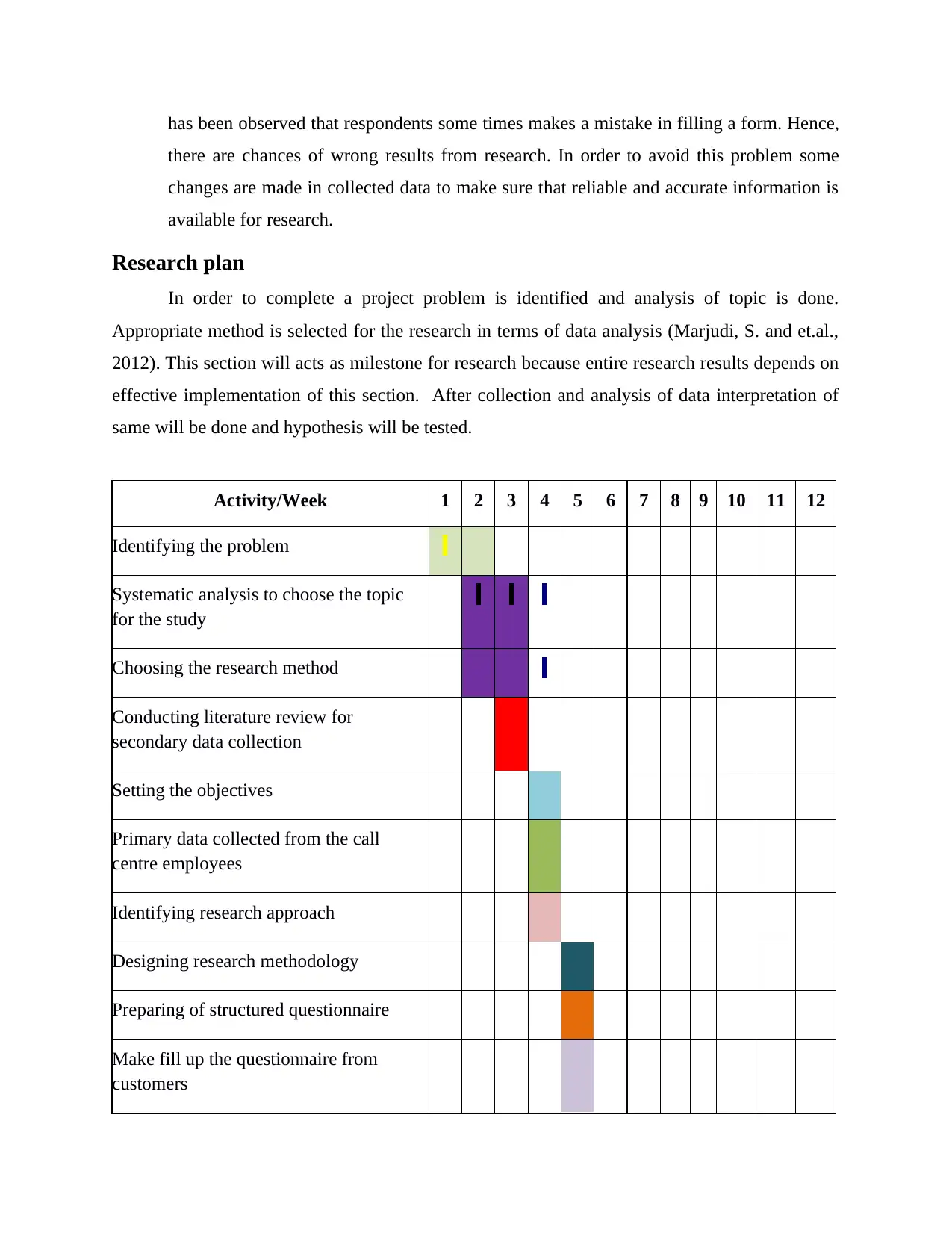
has been observed that respondents some times makes a mistake in filling a form. Hence,
there are chances of wrong results from research. In order to avoid this problem some
changes are made in collected data to make sure that reliable and accurate information is
available for research.
Research plan
In order to complete a project problem is identified and analysis of topic is done.
Appropriate method is selected for the research in terms of data analysis (Marjudi, S. and et.al.,
2012). This section will acts as milestone for research because entire research results depends on
effective implementation of this section. After collection and analysis of data interpretation of
same will be done and hypothesis will be tested.
Activity/Week 1 2 3 4 5 6 7 8 9 10 11 12
Identifying the problem
Systematic analysis to choose the topic
for the study
Choosing the research method
Conducting literature review for
secondary data collection
Setting the objectives
Primary data collected from the call
centre employees
Identifying research approach
Designing research methodology
Preparing of structured questionnaire
Make fill up the questionnaire from
customers
there are chances of wrong results from research. In order to avoid this problem some
changes are made in collected data to make sure that reliable and accurate information is
available for research.
Research plan
In order to complete a project problem is identified and analysis of topic is done.
Appropriate method is selected for the research in terms of data analysis (Marjudi, S. and et.al.,
2012). This section will acts as milestone for research because entire research results depends on
effective implementation of this section. After collection and analysis of data interpretation of
same will be done and hypothesis will be tested.
Activity/Week 1 2 3 4 5 6 7 8 9 10 11 12
Identifying the problem
Systematic analysis to choose the topic
for the study
Choosing the research method
Conducting literature review for
secondary data collection
Setting the objectives
Primary data collected from the call
centre employees
Identifying research approach
Designing research methodology
Preparing of structured questionnaire
Make fill up the questionnaire from
customers
Paraphrase This Document
Need a fresh take? Get an instant paraphrase of this document with our AI Paraphraser
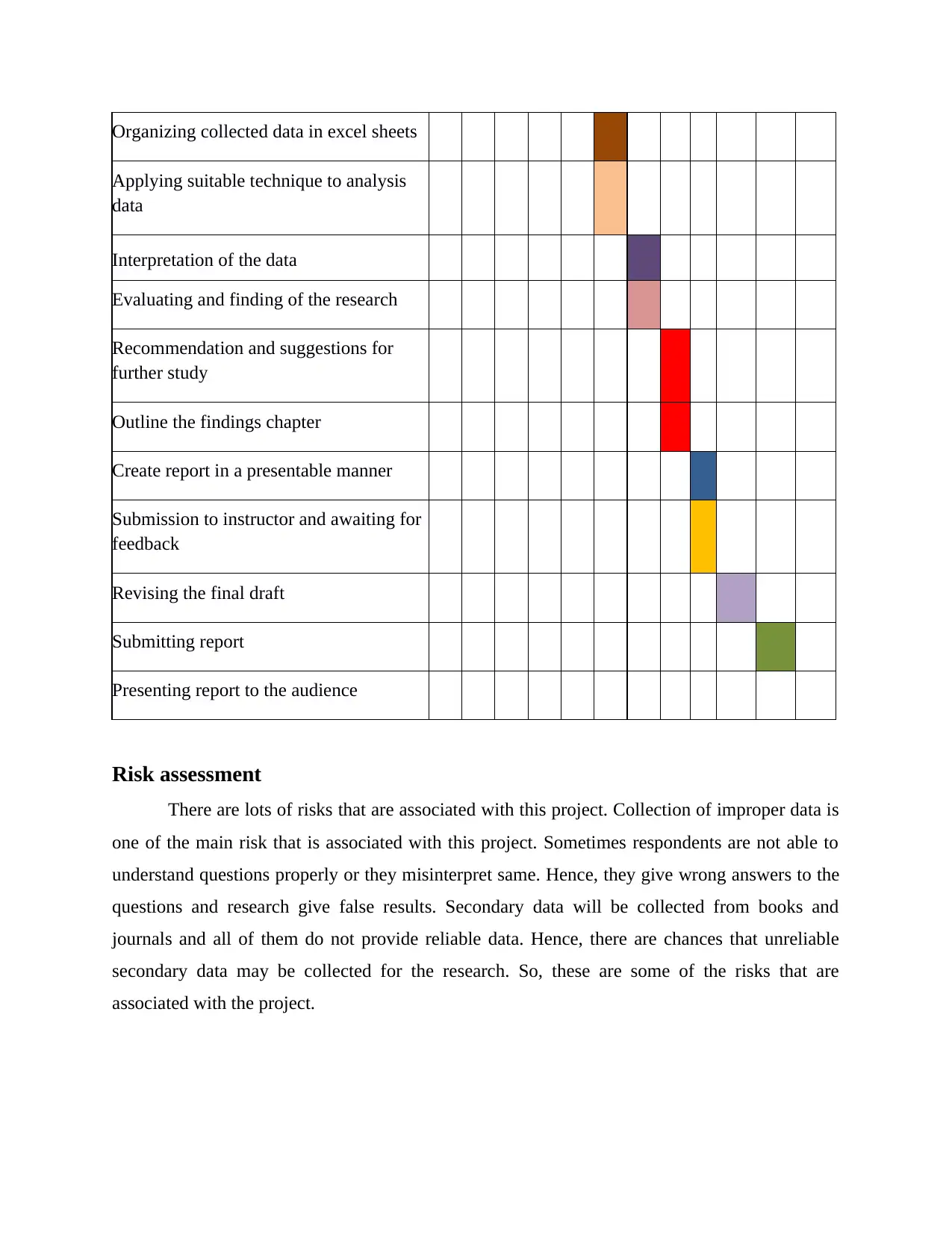
Organizing collected data in excel sheets
Applying suitable technique to analysis
data
Interpretation of the data
Evaluating and finding of the research
Recommendation and suggestions for
further study
Outline the findings chapter
Create report in a presentable manner
Submission to instructor and awaiting for
feedback
Revising the final draft
Submitting report
Presenting report to the audience
Risk assessment
There are lots of risks that are associated with this project. Collection of improper data is
one of the main risk that is associated with this project. Sometimes respondents are not able to
understand questions properly or they misinterpret same. Hence, they give wrong answers to the
questions and research give false results. Secondary data will be collected from books and
journals and all of them do not provide reliable data. Hence, there are chances that unreliable
secondary data may be collected for the research. So, these are some of the risks that are
associated with the project.
Applying suitable technique to analysis
data
Interpretation of the data
Evaluating and finding of the research
Recommendation and suggestions for
further study
Outline the findings chapter
Create report in a presentable manner
Submission to instructor and awaiting for
feedback
Revising the final draft
Submitting report
Presenting report to the audience
Risk assessment
There are lots of risks that are associated with this project. Collection of improper data is
one of the main risk that is associated with this project. Sometimes respondents are not able to
understand questions properly or they misinterpret same. Hence, they give wrong answers to the
questions and research give false results. Secondary data will be collected from books and
journals and all of them do not provide reliable data. Hence, there are chances that unreliable
secondary data may be collected for the research. So, these are some of the risks that are
associated with the project.
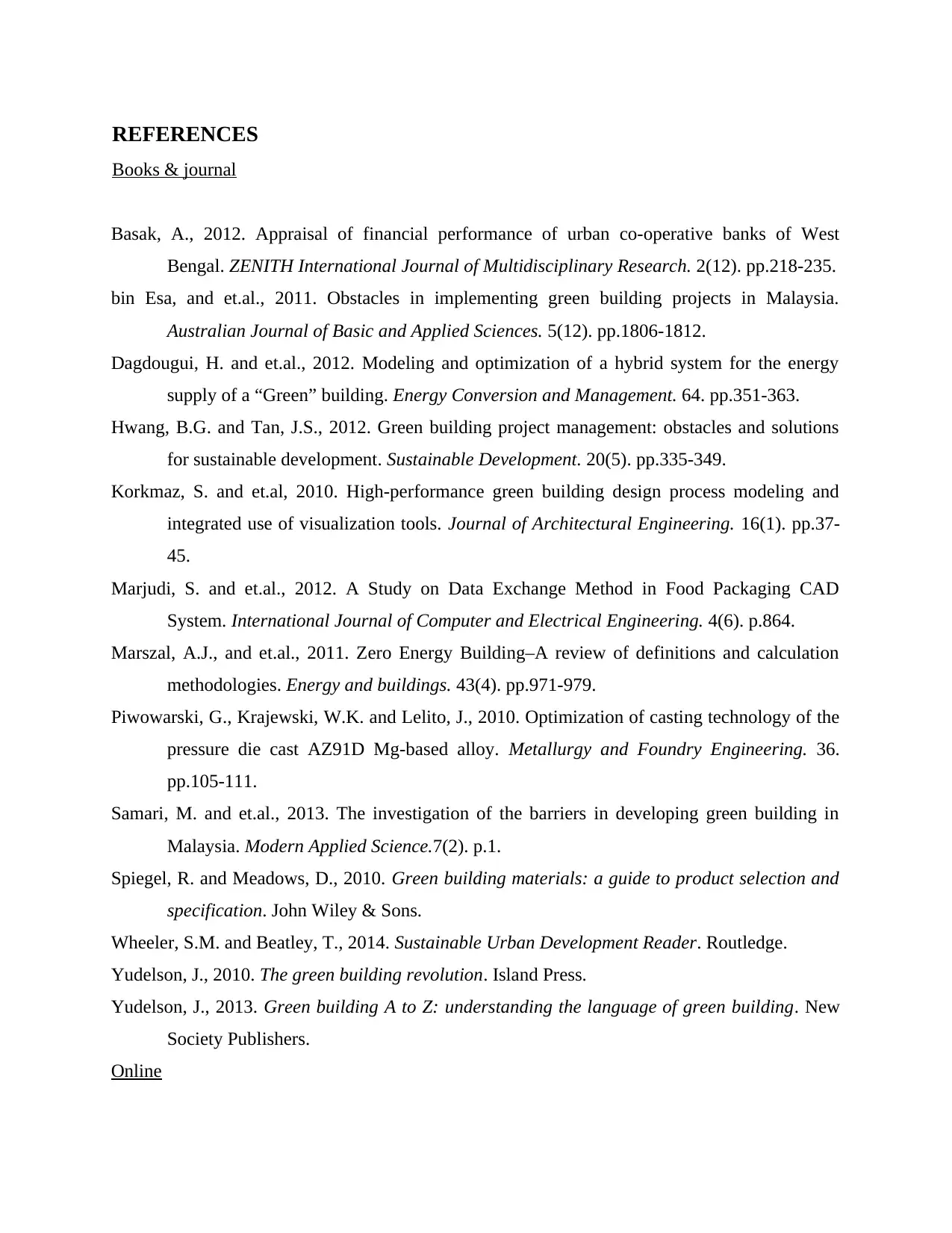
REFERENCES
Books & journal
Basak, A., 2012. Appraisal of financial performance of urban co-operative banks of West
Bengal. ZENITH International Journal of Multidisciplinary Research. 2(12). pp.218-235.
bin Esa, and et.al., 2011. Obstacles in implementing green building projects in Malaysia.
Australian Journal of Basic and Applied Sciences. 5(12). pp.1806-1812.
Dagdougui, H. and et.al., 2012. Modeling and optimization of a hybrid system for the energy
supply of a “Green” building. Energy Conversion and Management. 64. pp.351-363.
Hwang, B.G. and Tan, J.S., 2012. Green building project management: obstacles and solutions
for sustainable development. Sustainable Development. 20(5). pp.335-349.
Korkmaz, S. and et.al, 2010. High-performance green building design process modeling and
integrated use of visualization tools. Journal of Architectural Engineering. 16(1). pp.37-
45.
Marjudi, S. and et.al., 2012. A Study on Data Exchange Method in Food Packaging CAD
System. International Journal of Computer and Electrical Engineering. 4(6). p.864.
Marszal, A.J., and et.al., 2011. Zero Energy Building–A review of definitions and calculation
methodologies. Energy and buildings. 43(4). pp.971-979.
Piwowarski, G., Krajewski, W.K. and Lelito, J., 2010. Optimization of casting technology of the
pressure die cast AZ91D Mg-based alloy. Metallurgy and Foundry Engineering. 36.
pp.105-111.
Samari, M. and et.al., 2013. The investigation of the barriers in developing green building in
Malaysia. Modern Applied Science.7(2). p.1.
Spiegel, R. and Meadows, D., 2010. Green building materials: a guide to product selection and
specification. John Wiley & Sons.
Wheeler, S.M. and Beatley, T., 2014. Sustainable Urban Development Reader. Routledge.
Yudelson, J., 2010. The green building revolution. Island Press.
Yudelson, J., 2013. Green building A to Z: understanding the language of green building. New
Society Publishers.
Online
Books & journal
Basak, A., 2012. Appraisal of financial performance of urban co-operative banks of West
Bengal. ZENITH International Journal of Multidisciplinary Research. 2(12). pp.218-235.
bin Esa, and et.al., 2011. Obstacles in implementing green building projects in Malaysia.
Australian Journal of Basic and Applied Sciences. 5(12). pp.1806-1812.
Dagdougui, H. and et.al., 2012. Modeling and optimization of a hybrid system for the energy
supply of a “Green” building. Energy Conversion and Management. 64. pp.351-363.
Hwang, B.G. and Tan, J.S., 2012. Green building project management: obstacles and solutions
for sustainable development. Sustainable Development. 20(5). pp.335-349.
Korkmaz, S. and et.al, 2010. High-performance green building design process modeling and
integrated use of visualization tools. Journal of Architectural Engineering. 16(1). pp.37-
45.
Marjudi, S. and et.al., 2012. A Study on Data Exchange Method in Food Packaging CAD
System. International Journal of Computer and Electrical Engineering. 4(6). p.864.
Marszal, A.J., and et.al., 2011. Zero Energy Building–A review of definitions and calculation
methodologies. Energy and buildings. 43(4). pp.971-979.
Piwowarski, G., Krajewski, W.K. and Lelito, J., 2010. Optimization of casting technology of the
pressure die cast AZ91D Mg-based alloy. Metallurgy and Foundry Engineering. 36.
pp.105-111.
Samari, M. and et.al., 2013. The investigation of the barriers in developing green building in
Malaysia. Modern Applied Science.7(2). p.1.
Spiegel, R. and Meadows, D., 2010. Green building materials: a guide to product selection and
specification. John Wiley & Sons.
Wheeler, S.M. and Beatley, T., 2014. Sustainable Urban Development Reader. Routledge.
Yudelson, J., 2010. The green building revolution. Island Press.
Yudelson, J., 2013. Green building A to Z: understanding the language of green building. New
Society Publishers.
Online
⊘ This is a preview!⊘
Do you want full access?
Subscribe today to unlock all pages.

Trusted by 1+ million students worldwide

Importance of green building, 2016. [Online]. Available through:<
http://www.wncgbc.org/about/importance-of-green-building>. [Accessed on 20th May
2016].
http://www.wncgbc.org/about/importance-of-green-building>. [Accessed on 20th May
2016].
1 out of 10
Related Documents
Your All-in-One AI-Powered Toolkit for Academic Success.
+13062052269
info@desklib.com
Available 24*7 on WhatsApp / Email
![[object Object]](/_next/static/media/star-bottom.7253800d.svg)
Unlock your academic potential
Copyright © 2020–2025 A2Z Services. All Rights Reserved. Developed and managed by ZUCOL.





